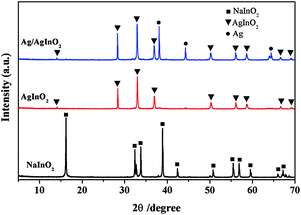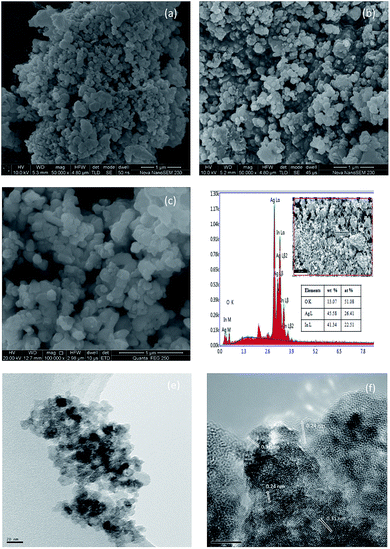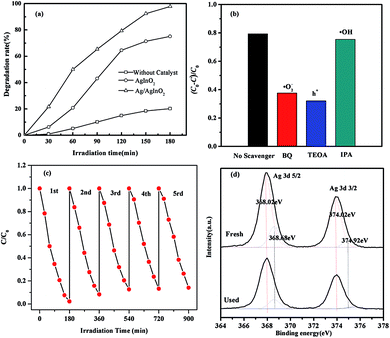 Open Access Article
Open Access ArticleFabrication of metal/semiconductor hybrid Ag/AgInO2 nanocomposites with enhanced visible-light-driven photocatalytic properties
Xiangchao Zhang *a,
Difa Xua,
Yanrong Jiaab and
Shiying Zhang*a
*a,
Difa Xua,
Yanrong Jiaab and
Shiying Zhang*a
aHunan Key Laboratory of Applied Environmental Photocatalysis, Changsha University, Changsha, Hunan 410022, P. R. China. E-mail: xczhang@ccsu.edu.cn; cdzhangshiying@163.com; Fax: +86-731-8426-1208; Tel: +86-731-8426-1297
bJiangsu Hengshen Co., Ltd., Danyang, Jiangsu 212314, P. R. China
First published on 12th June 2017
Abstract
Recently, exploration of the potential application of heterogeneous photocatalysis has attracted significant interest in the fields of environmental remediation and energy conversion. The metal–semiconductor hybrid nanostructures play very important roles in solar-to-chemical energy conversion due to their unique optical characteristics and catalytic properties. In this study, a novel photocatalyst constructed using Ag and AgInO2 was developed to improve the visible-light-driven properties. The photocatalytic efficiency of Ag/AgInO2 for the degradation of methylene blue (MB) reached 97.8%, which was much higher than that of pure AgInO2. Characterization results show that the as-prepared nanocomposites can not only broaden the visible-light absorption range but also promote the separation of the photogenerated electron–hole pairs. Trapping experiments confirmed that superoxide radicals (˙O2−) and holes (h+) were the predominant contributors in the degradation of the organic dye MB. These encouraging results provide an alternative approach for the development of metal–semiconductor hybrid nanostructures towards improving the efficiency of solar-energy utilization in the near future.
1. Introduction
Nowadays, harnessing of the solar energy to chemical energy conversion via photocatalysis is one of the hottest research topics because of its potential to solve increasingly serious energy shortages and environmental pollution problems.1 Undoubtedly, semiconductor-based heterogeneous photocatalysis, as a green and sustainable technology, continues to attract significant attention due to its substantial progress in water and air pollution treatment, H2 generation and CO2 conversion, and artificial photosynthesis.2–4 In the perspective of efficient utilization of solar light, extensive efforts have been devoted to the exploration of visible-light-driven photocatalysts for environmental and energy-related applications. To date, several types of oxides, sulfides, nitrides, and other photocatalysts have been developed.5–8 However, the efficiency of the existing photocatalysts is restricted by the low absorption capacity and/or the fast charge carrier recombination to meet the requirements of commercial applications. Thus, it is particularly important to explore an efficient strategy for the design and preparation of advanced photocatalytic materials with high efficiencies.In the past decade, Ag-based photocatalysts have been rapidly developed, which have been proven to be one of the most attractive candidates with high photocatalytic efficiency under visible-light irradiation.9 On the other band, exploration of an efficient strategy to improve the photocatalytic performances remains a great challenge; one of the efficient approaches include the combination of noble metal co-catalysts (such as silver and gold) with semiconductors to construct nanocomposites.10 Furthermore, the hybrid between a semiconductor and a metal can produce an active interface and enhance the interfacial charge separation.11 Some studies have reported that the metal/semiconductor hybrid photocatalysts, such as Ag/AgPO3, Ag/SrTiO3, Au/CdMoO4, Ni/CdS, and Bi/ZnWO4, have achieved important higher reaction rates in various photocatalytic reactions compared to their pristine counterparts.12–18 After this, Zhang et al. mentioned that despite the importance of Ag/semiconductor composites in heterogeneous photocatalysis, the interplay between Ag and semiconductors still remained largely unexplored.19 In our previous studies,20,21 our group has reported Ag/AgAlO2 composites and Ag/AgGaO2 metal–semiconductor heterostructures with the enhanced photocatalytic activities under visible-light irradiation. Based on the abovementioned studies, AgInO2, which belongs to the family of AgMO2 (M = Al, Ga, and In), is another promising Ag-based photocatalyst containing d10 metal ion electronic configuration of Ag+; however, to the best of our knowledge, to date, no study has been reported on the preparation of the Ag/AgInO2 nanocomposites as an efficient visible-light-responsive photocatalyst for organic dye decomposition.
Herein, we developed a novel metal–semiconductor hybrid of Ag/AgInO2 nanocomposites through a three-step method. The microstructure and optical properties of the as-prepared samples were investigated using XRD, SEM, EDS, TEM/HRTEM, XPS, PL, and UV-vis absorption spectra. The photocatalytic properties of the Ag/AgInO2 nanocomposites were evaluated by the photodegradation of an organic dye pollutant, MB solution, under visible-light irradiation. Compared to AgInO2, the Ag/AgInO2 nanocomposites exhibited superior photocatalytic activities. The proposed photocatalytic mechanism has also been discussed.
2. Experimental
2.1 Material preparation
All the chemicals were of analytical grade and used throughout the experiments without further purification. Since Ag2O decomposes at a temperature higher than 300 °C, it poses great challenges for the synthesis of silver compounds in a single-step via conventional solid-state reaction.22 A schematic of the preparation of the Ag/AgInO2 nanocomposite was proposed by the three-step method, as shown in Fig. 1. Typically, the precursor NaInO2 was synthesized via a solid-state reaction. Next, 0.01 mol In2O3 and 0.01 mol Na2CO3 were mixed and then sintered at 800 °C for 5 h to obtain the white NaInO2 powder. Second, the AgInO2 sample was prepared by an ion exchange method, which was carried out by heating the mixture of NaInO2, AgNO3, and KNO3 with a molar ratio of 1.0![[thin space (1/6-em)]](https://www.rsc.org/images/entities/char_2009.gif) :
:![[thin space (1/6-em)]](https://www.rsc.org/images/entities/char_2009.gif) 1.5
1.5![[thin space (1/6-em)]](https://www.rsc.org/images/entities/char_2009.gif) :
:![[thin space (1/6-em)]](https://www.rsc.org/images/entities/char_2009.gif) 1.0 at 220 °C for 10 h. Third, the hybrid Ag/AgInO2 products were fabricated through the thermal decomposition of the excess AgNO3 at 350 °C for 60 min to ensure the intimate contact between Ag and AgInO2. Finally, the precipitates were repeatedly washed with distilled water and dried at 80 °C in air for 5–8 h.
1.0 at 220 °C for 10 h. Third, the hybrid Ag/AgInO2 products were fabricated through the thermal decomposition of the excess AgNO3 at 350 °C for 60 min to ensure the intimate contact between Ag and AgInO2. Finally, the precipitates were repeatedly washed with distilled water and dried at 80 °C in air for 5–8 h.
2.2 Sample characterization
The crystalline structure of the as-obtained samples was determined using a Bruker AXS D8 Advance X-ray diffractometer with Cu Kα radiation (λ = 0.15406 nm) in the 2θ range from 10° to 70°. The morphological characteristics and microstructures of the products were examined by field-emission scanning electron microscopy (FESEM; equipped with energy-dispersive X-ray spectroscopy (EDS), JEOL model JSM-6360LV) and high-resolution transmission electron microscopy (HRTEM, JEM-3010). The ultraviolet-visible (UV-vis) absorption spectra were acquired by a UV-vis spectrometer (UV-2450, Shimadzu) in the range from 200 to 700 nm using BaSO4 as the reference. Photoluminescence (PL) spectra were obtained using a fluorescence spectrophotometer (F-7000, Hitachi, Japan). X-ray photoelectron spectroscopy (XPS) measurement was performed using a spectrometer (Kratos AXIS Ultra DLD) equipped with an Al Kα X-ray radiation source. The XPS binding energy (BE) was internally referenced to the C 1s peak (BE = 284.6 eV).2.3 Evaluation of the properties
Photocatalytic activities of the as-prepared samples were evaluated by the degradation of MB under visible-light irradiation. The light source was a 300 W xenon lamp with a 400 nm cut-off filter. Experimental details have been previously published.21,23 Briefly, the photocatalytic reaction was carried out in an open reactor containing 200 mL of MB solution at a concentration of 10 mg L−1 and 0.2 g catalyst. Prior to irradiation, the solution suspension was magnetically stirred for 30 min to ensure adsorption/desorption equilibrium between the samples and MB solution in the dark. Every 30 min, we took out about 4 mL of suspension to analyze the MB concentration, which was tested by a Shimadzu UV-2450 spectrophotometer. The maximum absorption peak of MB was at λ = 664 nm. The degradation rate D was calculated as D = (C0 − Ct)/C0 × 100%, where C0 and Ct are the MB concentrations at initial state and after irradiation for t min, respectively.3. Results and discussion
The composition and crystallographic structure of the as-synthesized NaInO2, AgInO2, and Ag/AgInO2 composites were confirmed by the XRD patterns, as shown in Fig. 2.It was observed that the sharp diffraction peaks of the precursor can be well indexed as NaInO2 (JPCDS no. 65-3663). No diffraction peaks of the raw materials and other impurities were observed, indicating that the as-prepared samples were pure NaInO2 under the proposed conditions. The XRD pattern of AgInO2 shows typical diffraction peaks 2θ located at 14.0°, 28.3°, 32.9°, 36.9°, 50.3°, 56.1°, 58.6°, 64.0°, and 66.6°, corresponding to (003), (006), (012), (104), (018), (110), (0012), (116), and (202), respectively, which are well-indexed to the rhombohedral structure of AgInO2 with JCPDS no. 21-1077 (space group of R3m and calculated cell parameters a = b = 3.277 Å and c = 18.877 Å), suggesting that pure-phase AgInO2 is formed and well crystallized through an ion exchange reaction. For Ag/AgInO2, besides the peaks of AgInO2, the major diffraction peaks of the metal Ag (JCPDS no. 65-2871) are also present. Therefore, it is speculated from the XRD results that the nanocomposite based on the hybrid of metal Ag with semiconductor AgInO2 has been successfully prepared by the abovementioned three-step method.
The morphologies of the representative samples were determined using SEM and TEM/HRTEM. As shown in Fig. 3, no uniform morphologies were obtained in our experiment due to the preparation method, and the as-synthesized NaInO2, AgInO2, and Ag/AgInO2 samples were composed of irregular particles with the diameters about dozens to hundreds of nm in addition to a certain degree of agglomeration. The microstructures are the typical structures obtained from the solid-state method. EDS analysis in Fig. 2(d) shows that the atomic ratio of In![[thin space (1/6-em)]](https://www.rsc.org/images/entities/char_2009.gif) :
:![[thin space (1/6-em)]](https://www.rsc.org/images/entities/char_2009.gif) Ag
Ag![[thin space (1/6-em)]](https://www.rsc.org/images/entities/char_2009.gif) :
:![[thin space (1/6-em)]](https://www.rsc.org/images/entities/char_2009.gif) O is 1.0
O is 1.0![[thin space (1/6-em)]](https://www.rsc.org/images/entities/char_2009.gif) :
:![[thin space (1/6-em)]](https://www.rsc.org/images/entities/char_2009.gif) 1.17
1.17![[thin space (1/6-em)]](https://www.rsc.org/images/entities/char_2009.gif) :
:![[thin space (1/6-em)]](https://www.rsc.org/images/entities/char_2009.gif) 2.27. It is worth noticing that the molar ratio of Ag to In for the Ag/AgInO2 sample is 1.17
2.27. It is worth noticing that the molar ratio of Ag to In for the Ag/AgInO2 sample is 1.17![[thin space (1/6-em)]](https://www.rsc.org/images/entities/char_2009.gif) :
:![[thin space (1/6-em)]](https://www.rsc.org/images/entities/char_2009.gif) 1, which is higher than that in AgInO2 (1
1, which is higher than that in AgInO2 (1![[thin space (1/6-em)]](https://www.rsc.org/images/entities/char_2009.gif) :
:![[thin space (1/6-em)]](https://www.rsc.org/images/entities/char_2009.gif) 1). From the HRTEM images of the Ag/AgInO2 composites in Fig. 2(f), two lattice fringes at about 0.31 nm and 0.24 nm can be distinctly identified, in agreement with the spacing of the (006) plane of silver delafossite AgInO2 and the (111) plane of cubic Ag, respectively. Note that a heterojunction structure can be clearly observed between AgInO2 and Ag. This corresponds well with the results of the XRD as discussed above, which also lends support to the formation of Ag-loaded AgInO2.
1). From the HRTEM images of the Ag/AgInO2 composites in Fig. 2(f), two lattice fringes at about 0.31 nm and 0.24 nm can be distinctly identified, in agreement with the spacing of the (006) plane of silver delafossite AgInO2 and the (111) plane of cubic Ag, respectively. Note that a heterojunction structure can be clearly observed between AgInO2 and Ag. This corresponds well with the results of the XRD as discussed above, which also lends support to the formation of Ag-loaded AgInO2.
The optical properties of the pure AgInO2 and Ag/AgInO2 composites are shown in Fig. 4. As presented in the UV-vis absorption spectra in Fig. 4(a), it is clearly observed that both samples exhibit visible-light absorption in the range of 400–600 nm. In the case of the Ag/AgInO2 composite, the absorbance in the range of 400–700 nm is higher than that of pure AgInO2, which is attributed to the characteristic absorption of surface plasmon resonance (SPR) of metallic silver on the AgInO2 surface.13 The SPR effect of Ag can enhance the captured electron energy and transfer rate. The band gap energy (Eg) of the catalysts can be estimated according to the transformed Kubelka–Munk function obtained from a plot of light energy (αhν)1/2 versus photon energy hν. The indirect band gap of AgInO2 was evaluated to be 2.46 eV. Furthermore, an interesting finding is that the absorption edge of the Ag/AgInO2 composite shows an obvious red-shift and enhanced absorption in the visible light range was observed due to introduction of the metal Ag. These results imply that the extension towards longer wavelength and enhanced visible-light absorption of the hybrid Ag/AgInO2 can generate more available photogenerated carriers, thus favoring the photocatalytic activities for the degradation of the organic dye MB wastewater. On the other hand, because the PL emission results from the recombination charge carriers, the PL spectra of the semiconductors are useful to disclose the migration, transfer, and recombination processes of the photogenerated electron–hole pairs.24,25 Fig. 4(c) shows the PL spectra of the pure AgInO2 and Ag/AgInO2 composites under the excitation wavelength of 254 nm. From the results, it can be observed that the PL intensity of the Ag/AgInO2 sample becomes weaker as compared to that of the pure AgInO2, indicating that the Ag/AgInO2 hybrid can efficiently slow down the recombination of the photogenerated carriers; this is beneficial to the superior photocatalytic properties of the Ag/AgInO2 composites under visible light irradiation.
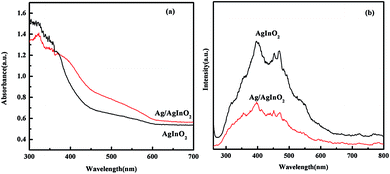 | ||
| Fig. 4 Optical properties of the pure AgInO2 and Ag/AgInO2 composites: (a) UV-vis absorption spectra and (b) PL spectra with excitation wavelength of 254 nm. | ||
The photocatalytic properties of the AgInO2 and Ag/AgInO2 samples were determined using MB dye as a target contaminant of wastewater. Fig. 5(a) shows the degradation rates of the MB solution in the presence of different samples. It was observed that the percent degradation of MB without a photocatalyst was very slow. The photocatalytic activities of the Ag/AgInO2 composites for the degradation of MB under 3 h visible-light irradiation reached 97.8%, which was much higher than that of the AgInO2 (only 75.1%) catalyst.
Fig. 5(b) shows the results of the active species trapping experiments to investigate the effects of a series of scavengers on the degradation rates of MB. Typically,26–28 three different chemicals, triethanolamine (TEOA, 0.01 mol L−1), isopropyl alcohol (IPA, 0.02 mol L−1), and p-benzoquinone (BQ, 0.1 mmol L−1), were employed as scavengers for photogenerated holes (h+), hydroxyl radical (˙OH), and superoxide radicals (˙O2−), respectively. The comparative experiment with no scavenger was also performed under identical conditions. It can be seen that there is only a slight decrease in the presence of IPA, indicating that the effect of hydroxyl radical (˙OH) on the photocatalytic degradation of MB by Ag/AgInO2 composites is negligible under visible-light irradiation. The photocatalytic degradation of MB remarkably decreases after adding TEOA, suggesting that holes (h+) are the main active species during the photocatalytic process. When BQ is added, the degradation efficiency of dye also decreases to 37.59%. It means that superoxide radical (˙O2−) plays an almost equally important role in the photodegradation reaction of MB. Therefore, it can be concluded that h+ and ˙O2− are the main active species for the photocatalysis of MB in the presence of the Ag/AgInO2 composites.
The reusability and stability of the Ag-based photocatalysts are the other important factors in the practical applications. The photocatalytic degradation percentage of MB obtained using the Ag/AgInO2 samples under visible-light irradiation in 5 cycles is shown in Fig. 5(c). There was no appreciable loss in the photocatalytic activity of the Ag/AgInO2 hybrid after the five runs; in addition to this, the XPS results, as shown in Fig. 5(d), exhibited that the characteristic peaks of Ag 3d of the recycled Ag/AgInO2 composites were almost similar to those of the fresh composites. It can be concluded that the hybrid Ag/AgInO2 composites possess admirable reusability and photostability even after five cycles for the degradation of MB dye. These encouraging results prove that the Ag/AgInO2 metal–semiconductor hybrid nanostructure can be expected to be a promising candidate in organic dye wastewater purification.
Based on the abovementioned experiment results as well as the ref. 29–36, we proposed the possible mechanism for the enhanced photocatalytic properties for the degradation of MB on a Ag/AgInO2 metal–semiconductor hybrid, as shown in Fig. 6. The band edge positions of the conduction band (CB) and the valence band (VB) of AgInO2 at the point of zero charge could be theoretically calculated by the Mulliken electronegativity theory: ECB = χ − EC − 1/2Eg. Herein, ECB is the conduction band edge energy and χ is the absolute electronegativity of the semiconductor. EC is the energy of free electrons in the hydrogen scale (∼4.5 eV), and Eg is the band gap energy of the semiconductor. EVB could be obtained by the equation of EVB = ECB + Eg. Thus, the values of CB and VB of AgInO2 were predicted to be −0.44 eV and 2.02 eV, respectively. When the Ag/AgInO2 composites are irradiated under visible light, the photogenerated electrons of AgInO2 can be excited from the VB to the CB; moreover, the holes stay at the VB to directly oxidize MB to degradation products because the VB potential of AgInO2 is more positive than the standard redox potential of ˙OH/OH− (1.99 V vs. NHE), and h+ can directly oxidize OH− to generate ˙OH radicals in the AgInO2 photocatalytic system. The as-produced ˙OH radicals can then degrade MB into CO2 and H2O. On the other hand, metallic Ag can also absorb visible light due to the SPR effect, and the absorbed photons would be efficiently separated into an electron and a hole. Moreover, an inner electromagnetic field can promote the higher separation efficiency of the photoproduced carriers when the metal Ag and the semiconductor AgInO2 are in direct contact. As a result, the photogenerated electrons on the Ag surface can be trapped by absorbed O2 in the solution to produce superoxide radical (˙O2−). These active species are strong oxidants that can photocatalyze MB to the degradation products. The proposed process can be described as follows:
| AgInO2 + hv → AgInO2(h+) + AgInO2(e−) | (1) |
| Ag + hv → Ag(h+) + Ag(e−) | (2) |
| O2 + e− → ˙O2− | (3) |
| h+ + MB → degradation products | (4) |
| ˙O2− + MB → degradation products | (5) |
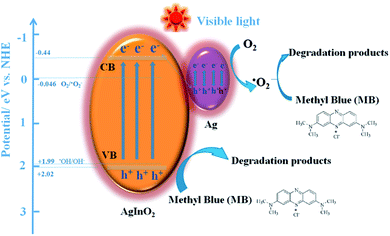 | ||
| Fig. 6 Schematic of the proposed mechanism for the degradation of MB on a Ag/AgInO2 metal–semiconductor hybrid. | ||
4. Conclusions
In conclusion, a novel Ag/AgInO2 metal–semiconductor hybrid nanostructure was designed and synthesized. The as-prepared Ag/AgInO2 nanocomposites exhibited enhanced photocatalytic activity (97.8%) for the degradation of MB as compared to that of a bare AgInO2 catalyst (75.1%). The UV-vis absorption spectra results indicated that the absorption edge of the Ag/AgInO2 composite showed an obvious red-shift and enhanced absorption in the visible-light range was observed. PL spectra demonstrated that the incorporation of the metal Ag onto the AgInO2 surface promoted the separation of the photogenerated carriers. The active species trapping experiments concluded that h+ and ˙O2− were the main active species in the photocatalysis of MB in the presence of the Ag/AgInO2 composites. This study provides some insight into the development of metal–semiconductor hybrid nanostructures for enhancing the visible-light-driven photocatalytic properties.Acknowledgements
This work was supported by the Program for the Hunan Provincial Natural Science Foundation of China (2016JJ6008), Scientific Research Fund of Hunan Provincial Education Department (17B029), and X. Zhang is grateful for the financial support received from the China Scholarship Council (201508430023).Notes and references
- X. Meng, L. Liu, S. Ouyang, H. Xu, D. Wang, N. Zhao and J. Ye, Adv. Mater., 2016, 28, 6781–6803 CrossRef CAS PubMed.
- J. Li, K. Zhao, Y. Yu and L. Zhang, Adv. Funct. Mater., 2015, 25, 2189–2201 CrossRef CAS.
- S. Wang, J. Yun, B. Luo, T. Butburee, P. Peerakiatkhajohn, S. Thaweesak, M. Xiao and L. Wang, J. Mater. Sci. Technol., 2017, 33, 1–22 Search PubMed.
- Z. Li, J. Feng, S. Yan and Z. Zou, Nano Today, 2015, 10, 468–486 CrossRef CAS.
- X. Li, J. Yu and M. Jaroniec, Chem. Soc. Rev., 2016, 45, 2603–2636 RSC.
- X. Zhu, P. Wang, B. Huang, X. Ma, X. Qin, X. Zhang and Y. Dai, Appl. Catal., B, 2016, 199, 315–322 CrossRef CAS.
- S. Guo, X. Li, J. Zhu, T. Tong and B. Wei, Small, 2016, 12, 5692–5701 CrossRef CAS PubMed.
- X. Li, J. Zhu and B. Wei, Chem. Soc. Rev., 2016, 45, 3145–3187 RSC.
- M. Akhtar, M. Menon, M. Sunkara, G. Sumanasekera, A. Durygin and J. Jasinski, J. Alloys Compd., 2015, 641, 87–92 CrossRef CAS.
- J. Bi, Z. Zhou, M. Chen, S. Liang, Y. He, Z. Zhang and L. Wu, Appl. Surf. Sci., 2015, 349, 292–298 CrossRef CAS.
- P. Bermel, K. Yazawa, J. Gray, X. Xu and A. Shakouri, Energy Environ. Sci., 2016, 9, 2776–2788 CAS.
- H. Dong, Z. Li, X. Xu, Z. Ding, L. Wu, X. Wang and X. Fu, Appl. Catal., B, 2009, 89, 551–556 CrossRef CAS.
- Q. Zhang, Y. Huang, L. Xu, J. Cao, W. Ho and S. Lee, ACS Appl. Mater. Interfaces, 2016, 8, 4165–4174 CAS.
- F. Tian, H. Zhao, G. Li, Z. Dai, Y. Liu and R. Chen, ChemSusChem, 2016, 9, 1579–1585 CrossRef CAS PubMed.
- D. Chen, Q. Chen, L. Ge, L. Yin, B. Fan, H. Wang, H. Lu, H. Xu, R. Zhang and G. Shao, Appl. Surf. Sci., 2013, 284, 921–929 CrossRef CAS.
- Y. Gao, Y. Huang, Y. Li, Q. Zhang, J. Cao, W. Ho and S. Lee, ACS Sustainable Chem. Eng., 2016, 4, 6912–6920 CrossRef CAS.
- O. Acuña, H. Villavicencio, V. Petranovskii and O. Herrera, Catal. Commun., 2016, 75, 103–107 CrossRef.
- S. Ouyang, N. Kikugawa, D. Chen, Z. Zou and J. Ye, J. Phys. Chem. C, 2009, 113, 1560–1566 CAS.
- T. Zhang, W. Lei, P. Liu, J. Rodriguez, J. Yu, Y. Qi, G. Liu and M. Liu, J. Phys. Chem. C, 2016, 120, 2777–2786 CAS.
- X. Zhang, Z. Luo, Y. Wang and S. Zhang, Chem. Lett., 2016, 45, 1288–1290 CrossRef CAS.
- X. Zhang, A. Tang, Y. Jia, Y. Wang, H. Wang and S. Zhang, J. Alloys Compd., 2017, 701, 16–22 CrossRef CAS.
- H. Dong, Z. Li, X. Xu, Z. Ding, L. Wu, X. Wang and X. Fu, Appl. Catal., B, 2009, 89, 551–556 CrossRef CAS.
- K. Xu, D. Xu, X. Zhang, Z. Luo and S. Zhang, Appl. Surf. Sci., 2017, 391, 645–653 CrossRef CAS.
- D. Xu, B. Cheng, J. Zhang, W. Wang and J. W. Ho, J. Mater. Chem. A, 2015, 3, 20153–20166 CAS.
- X. He, J. Wang, Z. Shu, A. Tang and H. Yang, RSC Adv., 2016, 6, 41765–41771 RSC.
- D. Xu, Y. Hai, X. Zhang, S. Zhang and R. He, Appl. Surf. Sci., 2017, 400, 530–536 CrossRef CAS.
- R. He, J. Zhang, J. Yu and S. Cao, J. Colloid Interface Sci., 2016, 478, 201–208 CrossRef CAS PubMed.
- B. Luo, D. Xu, D. Li, G. Wu, M. Wu, W. Shi and M. Chen, ACS Appl. Mater. Interfaces, 2015, 7, 17061–17069 CAS.
- A. Takai and P. Kamat, ACS Nano, 2011, 5, 7369–7376 CrossRef CAS PubMed.
- Y. Shahar, F. Scotognella, I. Kriegel, L. Moretti, G. Cerullo, E. Rabani and U. Banin, Nat. Commun., 2016, 7, 10413 CrossRef PubMed.
- S. Linic, P. Christopher and D. Ingram, Nat. Mater., 2011, 10, 911–921 CrossRef CAS PubMed.
- Z. Tong, D. Yang, Y. Sun and Z. Jiang, RSC Adv., 2015, 5, 56913–56921 RSC.
- Z. Bao, X. Xu, G. Zhou and J. Hu, Nanotechnology, 2016, 27, 305403 CrossRef PubMed.
- X. Li, L. Wang, D. Xu, J. Lin, P. Li, S. Lin and W. Shi, CrystEngComm, 2015, 17, 2421–2428 RSC.
- X. Xu, Z. Bao, G. Zhou, H. Zeng and J. Hu, ACS Appl. Mater. Interfaces, 2016, 8, 14118–14124 CAS.
- G. Zhou, X. Xu, T. Ding, B. Feng, Z. Bao and J. Hu, ACS Appl. Mater. Interfaces, 2015, 7, 26819–26827 CAS.
| This journal is © The Royal Society of Chemistry 2017 |


